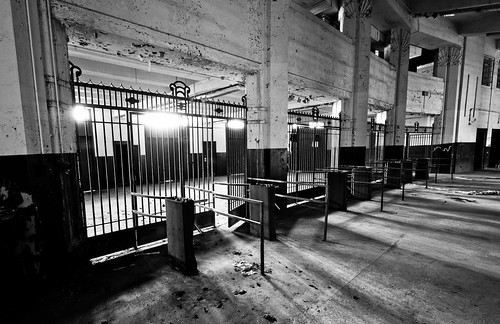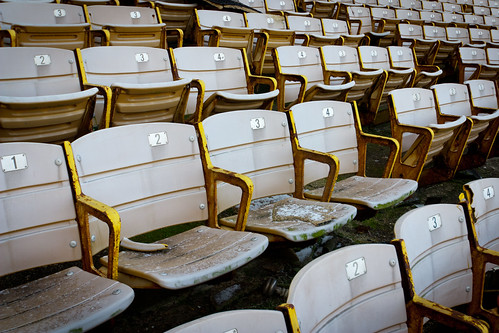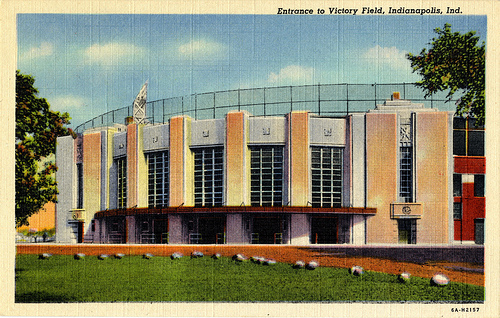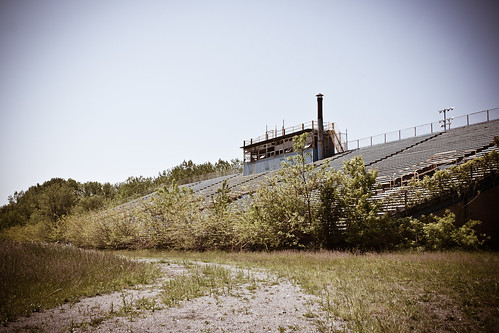
Photo: A stadium doomed from the very beginning.
Sports play a quintessential role in experiencing the American Dream. If you want to bet on your teams, you can conveniently do so online on sites such as 선시티카지노. On the field, court, track, pool or rink is where our heroes are born. It is a place where even those coming from less than ideal circumstances can rise above their social station. These venues are secular churches to the American Dream: a place where people can congregate, worship the spectacle of conflict, and adore those with seemingly superhuman abilities. On the western edge of Gleason Park in Gary, Indiana is such a church. Concrete walls are collapsing around the narthex. Weeds grow unfettered in the sanctum of the football field. The roar of the crowd in the pews are not but the chirping of fleeting birds. With no gods to worship, the American Dream is essentially dead at Gilroy Stadium.
In January, 1955 mayor Peter Mandich pushed the city council for the construction of a sports complex called the South Gleason Park Athletic Complex. Mandich promised the council that if costs exceeded their ability to pay that the project would go no further. The council decided to go forward with the construction of a stadium as the first element, funding construction to the tune of $350,000 in bonds. Several weeks later Mandich again appealed for funds to complete the stadium, stating “I’d much rather not build a stadium if we’re not going to build a decent one.” Throughout the bidding process city officials were given low-ball estimates to work with. Before long it was discovered that over $687,000 was already awarded to independent contractors. Cost overruns continued to loom as construction wrapped up in 1956 and the final bill amounted to $1 million dollars (or more than $8.5 million adjusted for inflation).
Comparing the stadium to another sports facility of the era illustrates just how horrendous spending on the project had become. Built in 1957 at a cost of $940,000, Lambeau Field in Green Bay, WI used 11,000 tons of steel to complete an NFL calibre venue that could seat 32,000 fans. The stadium in Gary, built in a city that the steel industry defined, used a paltry 630 tons and could only seat 10,000. Citizens were understandably livid at having to foot the cost of a substandard facility. Plans to construct additional sports facilities for the South Gleason Park Athletic Complex came to a screeching halt.
Despite the enormous amount of money poured into the football field several features were never finished. Bleachers, concession stands, and restroom facilities to accommodate 5,000 fans on the south side of the football field never materialized. Staff offices, maintenance facilities, and an additional locker room also never saw the light of day. Gravel for an eight lane running track surrounding the football field was laid down, but never actually paved.
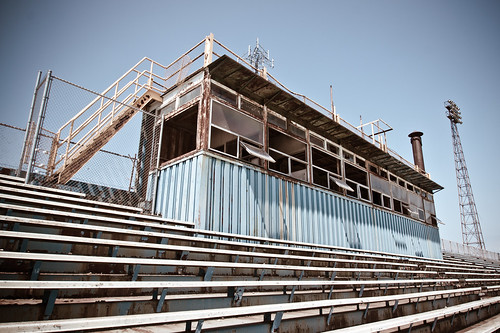
Photo: The press box has been cordoned off, but the field at large remains wide open.
The stadium took its namesake from local citizen John F. “Jack” Gilroy. He had come to the area in 1911 and took a gym teacher position at Emerson High School. The affable Gilroy rose to become the city’s first athletic director four years later. By the time the stadium was complete, and Gilroy ready to retire, the venue was named in his honor. At the grand opening on September 1, 1956 all eight area high schools participated in Football-O-Rama exhibition games.
By 1962 the façade that Mandich had enthusiastically pitched just a few years prior was beginning to literally fall apart. Building inspectors noted considerable cracking and moisture damage in the concrete supporting the bleachers. Scandal swirled around the field when federal investigation into six individuals involved with project were convicted for kickbacks and bribes during development. Nothing more than a coat of fresh paint was used to put the concerns about construction to rest.
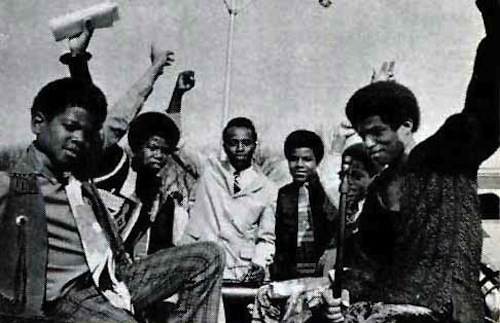
Photo (source): The Jackson 5 with Mayor Hatcher at Gilroy Stadium.
Between 1963 and 1973 local schools found Gilroy facilities unable to meet their needs. Most decided that it was in their best interest to construct their own facilities instead of paying rental fees, which hastened the decline of Gilroy Stadium. As the number of sporting events precipitously dwindled, city officials populated the schedule with alternative events. During the annual talent search in 1965 an upstart family act called The Jackson 5 won with their performance of “Bearfootin’.” Their stunning performance garnered the group’s first notable media mention in the local Gary Post Tribune. The Jackson 5 would return to Gilroy Stadium again in 1968, but this time they were signed under the famed music label Motown Records.
Over the next thirty years the languishing facility would only be used intermittently. Anecdotal evidence says that the scoreboard has not been lit since some point in the 1980s. Tower lights that went dark were no longer replaced. In 1994 concrete collapsed onto an electrical transformer, which knocked out power and lead to the cancellation of the Taste of Gary festival. Functional indoor plumbing only existed in the distant memories of those who knew the stadium in its prime. In between use weeds would consistently reclaim the surrounding area.
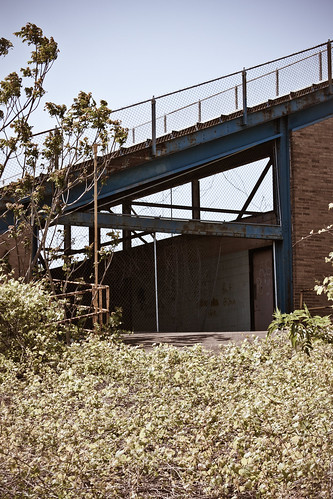
Photo: Weeds growing over the concourse up to the bleachers.
The beleaguered venue was again embroiled in controversy after the city granted the Ku Klux Klan the right to hold an event at the stadium in 2001. On the day of the gathering a crowd of protesters greatly outnumbered the 25 Klan members in attendance. It was reported that the protesters were able to drown out the hate speech by singing “We Shall Overcome” in unison.
A vast majority of the events at the stadium have been significantly more benign in comparison. The field has been sporadically used for a variety of concerts, friendly competitions, and other public gatherings. Because the bleachers were wholly unfit public use a significantly smaller set was constructed to accomodate audiences. Although the stadium was worse for wear, the Gary Golden Bears semi-pro football team called it home for 15 years.
In 2002 park department officials finally locked the gates and erected no trespassing signs around the perimeter fence. Curious explorers will find relatively little left behind at the barren stadium. Upper level concrete floors have begun to cave into the lower. Unlocked doors sway whenever the wind catches them right. The bleachers are faded white from a constant barrage of harsh sunlight. Vines have taken root and are working their way up with a level of patience only found in nature. Steel exposed to the elements has succumbed to relentless oxidation. On the north side a relatively new baseball diamond has been constructed, but even that has shows signs of neglect endemic to Gary.
As with many other building proposals planned for Gary the future of Gilroy Stadium seems to hang perpetually in the balance. One proposal to construct a casino on the property has all but stalled. Another proposal includes donating the property to be the future site of a museum dedicated to the memory of Michael Jackson. In the absence of sporting gods to worship, it seems almost fitting that the land be dedicated to other American deities: money and celebrity.
Resources:
Google Books – The Jackson 5 perform a benefit concert at the stadium in 1968.
Google Books – Two photos of people at Gilroy Stadium in its heyday.
Google Books – Briefly mentions Gilroy Stadium in relation to the Jackson’s home.
J5 Collector – Photo of The Jackson 5 during Gary’s Festival at the stadium in 1969.
Post Tribune – 1996 article on the troubled history of Gilroy Stadium.
Post Tribune – 2001 article comparing Gary, Indiana’s Gilroy Stadium to Lambeau Field in Green Bay, WI.
Post Tribune – 2001 article detailing the Ku Klux Klan rally event and protest.
Post Tribune – 2001 article citing the number of Ku Klux Klan members at the event.
Post Tribune – 2002 article on the uncertain future of the stadium.
Post Tribune – 2010 article on the details of a Michael Jackson museum.
Post Tribune – 2011 article on the stalled Michael Jackson museum.
Region Sports – An article on the rise and fall of Gilroy Stadium.
Region Sports – Miscellaneous facts about Gilroy Stadium.
The Jacksons – The Jackson 5 win an annual talent search at the stadium in 1965.
